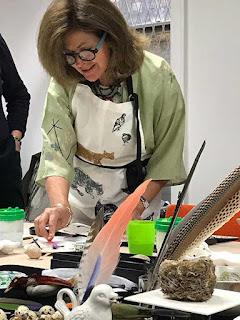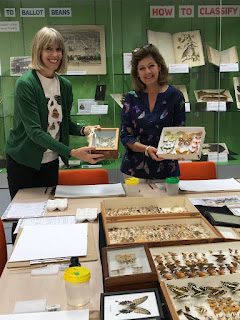After studying Natural History Illustration and Ecological Studies at the Royal College of Art, Sandy and Rebecca formed Drawn from Nature to continue the important work of teaching observational drawing of natural history.
Tell us about your practice and your journey to get to where you are now.
Art School started early for me at 17. Initially after a foundation year I took my first degree in Fine Art sculpture. After some years living in SE Asia, I returned to the UK and studied Botanical Illustration which led me down the path to The Royal College of Art and conservation. I started to feel as an artist that making ‘Art’ wasn’t enough. That one had to use it for a higher purpose, for the future. In botanical illustration my eyes had been opened to the work of the Bauer brothers, Maria Sibylla Merian and Margaret Mee among many others that we are still learning from today through their work. Serendipity landed me once more in Asia at a time when as now, vast areas of rainforest are disappearing along with its native flora and fauna. I set to work recording with paint and paper as much as I could over 10 years before returning to London and jointly creating with Rebecca Jewell Drawn from Nature so all may learn the skills needed to record species wherever they are, whether in a high rise flat or a country lane.
Tell us about ‘Drawn from Nature’ with Rebecca Jewell
We met at the Royal College of Art where we were both studying in the same department, Natural History Illustration and Ecological Studies. This course had been founded by John Norris Wood in 1971 and he taught there for over thirty years. We were two of John’s last students before he retired and the course was closed, he died in 2015. Realising that there were very limited places to study Natural History Illustration in the UK, we founded Drawn from Nature as a legacy to John but also to continue the important work of teaching observational drawing of natural history.
 |
| By Sandy Ross Sykes on Saunders Waterford |
Earlier in your career, you spent time in some extraordinary places - you spent years exploring remote forests in Southeast Asia - how have these experiences influenced your work?
Witnessing at first hand the rapidity of species loss in SE Asia makes me aware of how fragile our natural habitats are and how quickly they are lost forever and how important it is to record the times in which one lives as an artist. I am also greatly inspired by the C18th naturalist Gilbert White.
Given your interests in biodiversity and conservation, do you aim to raise awareness or convey specific messages through your work? If so, how?
An awareness of our surroundings is so important. These last 2 years I have been painting species on the UK red list of endangered species. We hear so much about the degradation of faraway rainforests and don’t see what we are losing from our own habitats. Art materials are an important factor in this work.
Good quality light fast watercolour paints which won’t fade, and archival paper such as that made by St Cuthberts Mill that will last centuries, are crucial to this work. Exhibiting paintings and also sharing the methods used to record species through our art classes are of great importance to the ethos of Drawn from Nature.
When I have painted a species often in difficult and remote places from a plant in situ, I then use herbarium techniques to dry and store the pressed plant in order that it can be compared to the painting by a botanist as many of the species I have painted are unknown to us here in the UK.
Over the years I have been able to collect many other items. The most shocking for me was a key ring bought in a market in southern China for less than £1 as a tiger’s claw. Surely it was a plastic replica I thought. But sickeningly it is real, and a lesson in how we need to do more to protect habitats and species.
What is the importance of drawing to you?
Drawing is the building block of art, but, it requires practice, if all you can manage is a 2 minute doodle a day do it!
What is your go-to drawing paper to use and why?
St Cuthberts Mill Saunders Waterford Hot Pressed 300gsm (140lb) traditional white. My work needs a smooth surface, so hot-pressed paper is best. I am a fan of Saunders Waterford in the traditional white as it may also be bought as single sheets and I use the large size for some of my big paintings. Good art materials are so important and so much skill goes into their manufacture. I hope to visit St Cuthberts Mill to learn more about the processes involved in making their papers.
During Works on Paper, you taught a class at Green & Stone called ‘Drawing and Painting Nature Specimens’ – can you tell us about it?
In our classes we share decades of knowledge that has been passed down to us as artists over the years. We structure our classes to pass on many tips and hints we have learnt ourselves. We also like to talk to our participants about the materials they are using…how their paper is made from cotton, and the history behind the coloured watercolours they are using. The specimens being painted are also full of fascinating stories. We have always had enthusiastic feedback and many of our students are loyal followers. We have found that our methods give the complete beginner confidence, and the established artist fresh inspiration. As the last graduates of The Royal College of Art’s ‘Natural History’ painting course, we feel passionate about sharing the skills needed for this work in order for it not to be lost.
UPCOMING WORKSHOP BY DRAWN FROM NATURE
For more details, visit:
https://www.thegalleryatgreenandstone.com/events/rebecca-jewell-sandy-sykes-nature-specimens
To view more of Sandy Ross Syke’s work, visit:
Links for Drawn from Nature
https://www.drawnfromnature.co.uk/
https://www.instagram.com/drawnfromnature
To learn more about the Saunders Waterford range visit our website.
Article originated by The Gallery at Green & Stone, as part of their 'Works on Paper' exhibition. Our thanks to them for allowing us to replicate the piece.








No comments:
Post a Comment